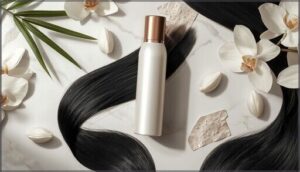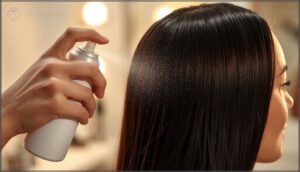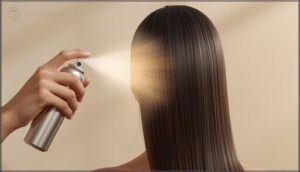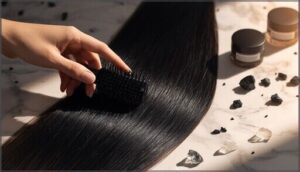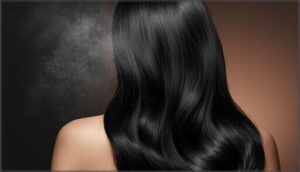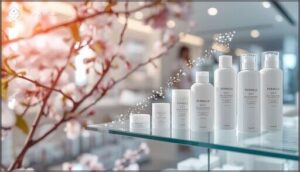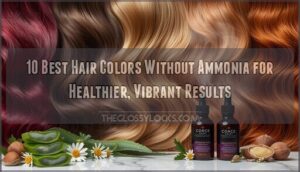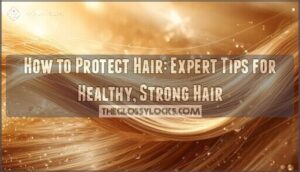This site is supported by our readers. We may earn a commission, at no cost to you, if you purchase through links.
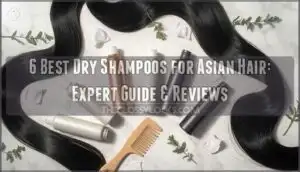 Your grandmother’s advice about washing hair every day? She wasn’t wrong for straight, fine Asian hair—daily washing often feels necessary because oil spreads down the shaft faster than it does on curly or coarse textures.
Your grandmother’s advice about washing hair every day? She wasn’t wrong for straight, fine Asian hair—daily washing often feels necessary because oil spreads down the shaft faster than it does on curly or coarse textures.
But here’s the catch: overwashing strips your scalp’s natural barrier, triggering even more oil production. That’s where dry shampoo becomes your secret weapon. The right formula absorbs excess sebum without the chalky residue that plagued earlier products, extending your wash cycles while maintaining volume and freshness.
With Asian hair’s unique structure demanding specific absorbent ingredients and ultra-fine particles, choosing a dry shampoo that actually works—not one that leaves you looking grey or feeling sticky—makes all the difference.
Table Of Contents
- Key Takeaways
- Top 6 Dry Shampoos for Asian Hair
- Key Benefits of Dry Shampoo for Asian Hair
- How to Choose The Right Dry Shampoo
- Dry Shampoo Application Tips for Asian Hair
- Maintaining Healthy Hair and Scalp
- Market Trends and Consumer Preferences
- Where to Buy Dry Shampoos at Best Value
- Frequently Asked Questions (FAQs)
- Does dry shampoo work on all hair types?
- How often should I use dry shampoo?
- Is dry shampoo better than traditional shampoo?
- Does dry shampoo damage hair?
- Does dry shampoo work on curly hair?
- How does humidity affect dry shampoo performance?
- Are aerosol or powder formulas better for Asian hair?
- Can dry shampoo be used on wet hair?
- Does dry shampoo protect against UV damage?
- Conclusion
Key Takeaways
- Asian hair’s straight structure and high sebum production means oil spreads down the hair shaft faster than curly or coarse textures, making frequent washing feel necessary—but overwashing strips your scalp’s natural barrier and triggers even more oil production, which is where the right dry shampoo becomes essential for extending wash cycles without damage.
- The best dry shampoos for Asian hair use ultra-fine particles (rice starch, silica, or clay) that absorb oil without leaving white residue on dark hair, with tinted formulas specifically designed to disappear into darker strands while maintaining volume—products like Amika Perk Up and Living Proof deliver invisible finishes that work with Asian hair’s unique texture.
- Proper application technique matters more than the product itself: hold the bottle 6–8 inches from your scalp, spray directly at oily roots in sections, massage thoroughly into your scalp with fingertips to prevent chalky buildup, and limit use to 2–3 times weekly between regular washes to maintain scalp health and avoid follicle clogging.
- Market trends show Asian consumers increasingly prioritize natural, paraben-free formulas with scalp-health ingredients like antioxidants and biotin rather than just oil absorbers, with the Asia Pacific dry shampoo market growing at 8.2% annually as urban professionals embrace convenient hair care solutions that respect their hair’s thickness and cultural grooming standards.
Top 6 Dry Shampoos for Asian Hair
Finding the right dry shampoo for Asian hair means choosing formulas that tackle excess oil without leaving residue on thick, straight strands.
I’ve tested dozens of options to identify products that work specifically for our hair texture and oiliness patterns.
Here are six standouts that deliver real results between wash days.
1. Amika Perk Up Dry Shampoo
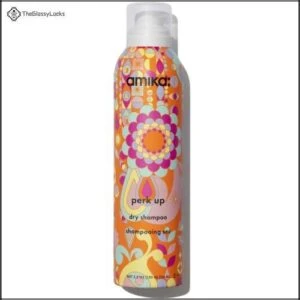
Amika Perk Up stands out as the number one prestige dry shampoo in the U.S., earning a 4.8-star rating across hair types—including Asian hair. Rice starch absorbs oil without white residue, while sea buckthorn delivers vitamins for scalp health.
This vegan-certified formula uses a hydrocarbon propellant, and tests show benzene levels well below safety thresholds.
At $28 for 5.3 oz, it’s pricier than drugstore options, but the invisible finish works beautifully on darker Asian hair tones, keeping your style fresh between washes without weighing down fine strands.
Best For: Anyone with darker, oil-prone Asian hair who wants an invisible, weightless dry shampoo that absorbs oil quickly without leaving white residue or weighing down fine strands.
- Rice starch formula leaves zero white cast on dark hair and absorbs oil effectively while adding volume
- Talc-free, vegan, and safety-tested with no detectable benzene—plus sea buckthorn adds vitamins for scalp health
- Lightweight and buildable so you can use it multiple times without product buildup between washes
- At $28 for 5.3 oz, it’s significantly pricier than drugstore alternatives like Batiste
- Some users find the can design awkward to hold and the scent too strong
- May require several sprays to get the oil absorption you need, especially if your hair gets oily fast
Clean Freak Dry Shampoo 2-Pack
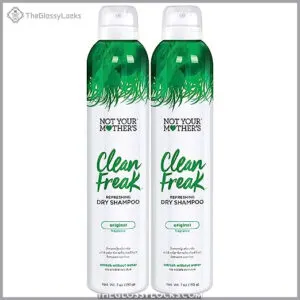
If you’re looking for a budget-friendly option, Not Your Mother’s Clean Freak Dry Shampoo 2-Pack delivers solid performance at $8.99 per 7-ounce bottle. Rice and barley starches absorb oil without leaving white residue—a huge win for Asian hair—while the aluminum-free, sulfate-free formula promotes ingredient safety for color-treated or sensitive scalps.
Consumer feedback highlights its ability to refresh oily-prone Asian hair types and add volume to fine strands.
You’ll find it at major retailers, often with promotional deals that drop the price even lower. Travel sizes are available too, making it easy to keep your hair fresh on the go.
Best For: Anyone with Asian hair looking for an affordable, no-residue dry shampoo that absorbs oil quickly without harsh chemicals or visible powder on dark strands.
- Rice and barley starches absorb oil effectively without leaving white residue, which is especially important for darker Asian hair tones.
- Aluminum-free, sulfate-free, and vegan formula makes it safe for color-treated and sensitive scalps.
- Great value at $8.99 per 7-ounce bottle, with frequent promotional deals and bulk options for even more savings.
- Some users find the citrus scent too strong or overpowering for daily use.
- Can leave residue or make hair feel brittle if you apply too much at once.
- May lose effectiveness toward the end of the bottle, and the large can isn’t ideal for travel.
Dry Shampoo, Tropical, 3-Pack
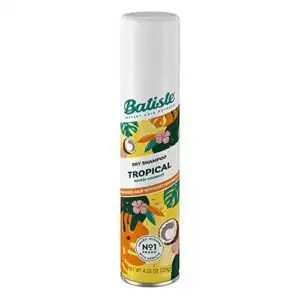
Batiste Dry Shampoo, Tropical, 3-Pack brings a vacation vibe to your hair care routine with coconut, jasmine, and vanilla notes. Rice starch absorbs oil effectively, and at $16.10 for a 200ml size, it’s a solid mid-range choice.
Asian hair benefits from its lightweight formula, though you’ll need to massage and brush thoroughly to avoid white residue on darker strands.
The travel-friendly 3.81 oz cans fit easily in your bag, and with a 4.7/5 star rating from 518 reviews, it’s a crowd favorite for quick refreshes between washes.
Best For: People with oily hair who want a quick refresh between washes and love tropical scents, especially those who need travel-friendly options.
- Rice starch absorbs oil effectively and adds volume, with 81% of 518 reviewers giving it 5 stars for oil control
- Long-lasting coconut, jasmine, and vanilla scent keeps hair smelling fresh for hours
- Travel-sized 3.81 oz cans are perfect for gym bags, vacations, or busy days on the go
- Requires thorough massaging and brushing to avoid white residue, especially on dark or black hair
- Strong tropical fragrance may be overwhelming for people sensitive to scents
- Not as effective on extremely dirty or greasy hair—works best for light to moderate oil buildup
Organic Dry Shampoo Powder Lavender
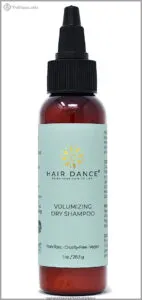
Hair Dance’s Organic Dry Shampoo Powder Lavender offers a non-aerosol alternative that’s especially worth considering if you have scalp sensitivity or prefer organic ingredients. At $9.99 for 2oz, it’s talc-free, paraben-free, and vegan—addressing concerns many of you have about harsh chemicals on Asian hair.
The powder application takes practice since you twist the cap to control how much comes out, but once you get the hang of it, lavender benefits include calming your scalp while absorbing oil. It works well for oily hair types and adds volume without baking soda or phthalates.
Just know it can be messier than aerosol dry shampoos, and blending takes extra effort on dark strands.
Best For: People with oily Asian hair who prefer organic, chemical-free alternatives and don’t mind a learning curve with powder application.
- Clean formula without talc, parabens, baking soda, or phthalates—gentle on sensitive scalps common with Asian hair types.
- Adjustable dispensing cap lets you control powder amount, reducing waste and messiness once you get the technique down.
- Affordable at $9.99 for 2oz, with lavender scent that calms scalp irritation while absorbing oil and adding volume.
- Powder format is messier than aerosol sprays and takes practice to apply evenly, especially on dark Asian hair where blending is crucial.
- Volume boost may not last all day for users with very fine or heavy hair textures.
- Blending the powder into darker hair colors requires extra effort and time compared to tinted dry shampoos.
No-Wash Dry Shampoo Refresh
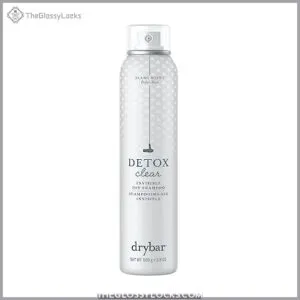
Switching to a no-wash format can be a significant shift when you’re juggling a hectic schedule. No-Wash Dry Shampoo Refresh products use alcohol and surfactants to lift oil without water, making them incredibly convenient for travel or post-gym touch-ups.
Asian consumers especially appreciate formulas that avoid residue visibility on dark strands while supporting scalp microbiome balance. Japanese-style versions with fermented rice can even improve cuticle alignment, leaving your hair smoother.
Over 92% of users report fresher-smelling hair and better oil absorption, which boosts hair self-perception. Just remember to pair it with regular washing to prevent buildup.
Best For: Busy professionals, frequent travelers, and anyone with an active lifestyle who needs quick oil absorption and fresh-smelling hair between traditional washes without visible residue.
- Invisible, lightweight formula absorbs oils and impurities while leaving hair soft and refreshed, with 92% of users reporting cleaner-smelling hair and reduced visible oil.
- Works on all hair types (straight, wavy, curly, coily) and is vegan, cruelty-free, sulfate-free, paraben-free, and gluten-free, making it suitable for sensitive scalps.
- Convenient aerosol spray format with potato starch, kiwi extract, and amla oil that adds light texture while extending time between washes for on-the-go use.
- May not be effective for more than 2-3 days without traditional washing, and can lead to buildup if not paired with regular shampooing.
- Expensive for the amount of product provided, which may not be cost-effective for daily or frequent users.
- Some users find the scent overpowering, and it may not provide enough oil absorption for very greasy hair or those preferring a matte finish.
Living Proof Dry Shampoo
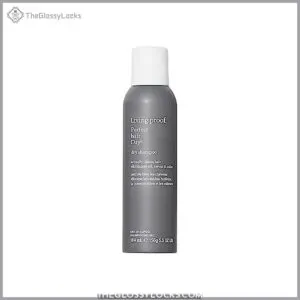
When you want a dry shampoo that truly delivers, Living Proof Dry Shampoo earns its reputation with a patented OFPMA Molecule that repels dirt and locks in freshness. Oil absorption is outstanding—even on day-three Asian hair—without the heavy residue you’d worry about on dark, straight strands.
The time-released scent strength can feel bold, so test it first if you’re sensitive. For Asian suitability, it checks every box: starch-based powders prevent white cast, benzene-free formulation keeps things safe, and conditioning agents add shine.
Residue concerns? A quick massage works it through beautifully, making this a go-to for professionals seeking hair care that respects both science and style.
Best For: People with all hair types who want a premium dry shampoo that actually cleans hair, absorbs oil effectively, and works well on dark or Asian hair without leaving visible residue.
- Patented OFPMA formula genuinely removes oil and sweat rather than just masking it, extending time between washes even on day-three hair.
- Works exceptionally well on Asian and dark hair types with minimal white cast when properly massaged through, thanks to starch-based powders.
- Adds noticeable volume and shine while leaving hair soft and manageable, not crunchy or powdery like talc-based alternatives.
- Expensive at $33 compared to drugstore options, making it a significant investment for a dry shampoo.
- Strong time-release scent can be overpowering for those sensitive to fragrance or who prefer unscented products.
- Some users report nozzle failures after limited use, and the heavy fog during application raises concerns about inhalation.
Key Benefits of Dry Shampoo for Asian Hair
If you’ve got thick, straight Asian hair, you know how quickly it can look slick with oil. Dry shampoo isn’t just a quick fix—it’s a revelation that combats grease, adds life to flat roots, and buys you precious time between washes. Here’s what makes it worth keeping in your routine.
Oil Absorption and Grease Control
If you’ve got Asian hair, you already know that oiliness can show up faster than other hair types—and that’s where the right dry shampoo becomes your secret weapon. Asian hair’s larger diameter and higher sebum production mean greasy hair becomes visible within a day or two. Quality dry shampoos tackle oil control through ingredient efficacy—absorbing excess oil before buildup compromises scalp health.
Here’s what effective oil absorption delivers:
- Extends cleansing frequency between washes without stripping natural oils
- Targets greasy hair at the roots where Asian hair collects oil fastest
- Maintains proper application techniques to prevent product buildup while controlling shine
Volume and Texture Boost
Flat, lifeless strands clinging to your scalp aren’t what most people picture when they skip a wash—but for Asian hair’s naturally straight structure, volume disappears fast without the right boost.
Dry shampoos create root lift by absorbing oils that weigh down hair thickness, giving fine hair immediate styling benefits.
Product layering with the right formula transforms flat Asian hair into textured, fuller-looking strands—especially when you target application at your roots where hair volume matters most.
Reducing Wash Frequency
Every wash you skip with dry shampoo buys you breathing room in a schedule that doesn’t always make space for a blow-dryer and styling routine. For Asian hair’s high oil production, extending time between washes protects your scalp microbiome while respecting cultural norms around polished appearance.
Dry shampoos offer practical hair washing alternatives that prevent product buildup when used correctly:
- Reduces mechanical stress from frequent washing and heat styling
- Maintains natural oils deeper in your hair shaft for healthier texture
- Upholds scalp health by limiting disruption to protective barrier functions
- Saves time without sacrificing workplace or social grooming standards
Strategic dry shampoo benefits include preserving Asian hair’s natural strength while adapting to modern demands.
Refreshing Hair and Controlling Odor
Between gym sessions, client meetings, and the humidity that follows you everywhere, your hair picks up more than just styling—it collects odors that settle into Asian hair’s dense structure faster than you’d think. Dry shampoo offers odor neutralization and scalp refreshment by absorbing sweat and environmental particles that cling to thick strands. Quality formulas deliver a clean hair feel with fragrance longevity that doesn’t just mask smells—they eliminate them.
| Feature | How It Benefits Asian Hair |
|---|---|
| Odor Neutralization | Charcoal and clay ingredients trap odor molecules in dense hair structure |
| Sweat Absorption | Silica particles absorb moisture from scalp and roots after workouts |
| Scalp Refreshment | Light formulas revive hair without weighing down thick strands |
| Fragrance Longevity | Extended-release scents maintain clean feel between washes |
| Hair Cleansing | Quick hair refresh removes environmental buildup and pollutants |
How to Choose The Right Dry Shampoo
Finding the right dry shampoo isn’t just about grabbing the first bottle you see—it’s about matching the formula to your hair’s specific needs. Asian hair has its own quirks, from that telltale oil buildup to straight strands that can show residue in a heartbeat.
Here’s what to look for when you’re shopping.
Absorbent Ingredients (Silica, Clay, Charcoal)
When you’re picking a dry shampoo for Asian hair, the absorbent ingredient matters more than you might think—silica, clay, and charcoal each tackle oil differently, and knowing which one works best for your hair type can mean the difference between fresh, voluminous roots and a chalky mess.
Silica benefits include ultra-fine powder fineness that disappears quickly, making it ideal for darker Asian hair. Clay types like kaolin absorb oil more aggressively, perfect if you deal with excessive grease.
Charcoal sourcing from bamboo or coconut adds gentle detoxification while controlling oil absorption in hair—just check ingredient safety labels to avoid harsh additives that might irritate your scalp.
Color and Finish (Clear Vs. Tinted)
Once you’ve nailed down the right absorbent ingredient, the next thing is whether a clear or tinted dry shampoo will work better for your hair color—because nothing kills the vibe faster than white, chalky streaks running through your dark Asian hair.
Tinted benefits include eliminating white residue on darker strands, while clear advantages work universally across hair colors.
Color matching matters—look for formulas specifically labeled for dark hair to avoid residue visibility issues that plague many dry shampoos for Asian hair.
Scent Preferences (Fragranced Vs. Unscented)
After you’ve sorted out color and finish, scent is where personal preference really kicks in—some people love a fresh floral or citrus boost that masks scalp odor between washes, while others prefer a formula that won’t clash with their signature perfume or trigger headaches.
Fragrance allergies are real, so if you’ve had reactions to synthetic fragrances before, an unscented dry shampoo is your safest bet.
Scent intensity also varies—heavily fragranced options can overwhelm, especially in professional settings where cultural preferences lean toward subtler grooming products.
Suitability for Oily or Fine Hair
Your hair type matters more than you might think—oily hair can benefit from richer, powder-based formulas with silica or clay that really soak up sebum, while fine hair needs ultra-lightweight sprays or aerosols that won’t weigh down strands or leave a gritty feel. Asian hair is often in both camps, so matching your product to your specific needs prevents buildup and keeps volume intact.
- Oily hair types benefit from charcoal-based dry shampoos that target excess sebum without multiple applications
- Fine hair needs transparent, micro-fine powders that disappear instantly and won’t flatten your style
- Volume enhancement works best when formulas lift at the root without residue that drags hair down
- Scalp sensitivity calls for alcohol-free options that refresh without irritation or flaking
Dry Shampoo Application Tips for Asian Hair
Getting dry shampoo to work right on Asian hair isn’t complicated, but a few tweaks make all the difference. Your hair’s unique texture—thick, straight, and prone to oiliness—means the usual spray-and-go approach won’t cut it.
Here’s how to apply dry shampoo so it actually does its job without leaving a chalky mess behind.
Step-by-Step Usage Guide
Getting dry shampoo to work its magic on Asian hair isn’t about shaking and spraying randomly—it’s about technique that respects your hair’s thickness and oil production patterns.
Start by sectioning your hair, then keep the bottle 6–8 inches from your scalp—this application distance prevents concentrated white patches. Spray directly at hair roots where oil collects, then massage the product into your scalp using your fingertips to distribute it evenly through each layer.
How Much Product to Apply
Too much product turns your roots chalky and ruins the effect—too little leaves you greasy by noon. For Asian hair’s thickness and oil production, start with 2–3 short bursts per section—you can always add more.
Focus on even distribution through application frequency adjustments: if your roots feel saturated or look powdery, you’ve gone too far. Hair care tips for dry shampoo usage come down to observing how your hair responds after each application.
Preventing Residue and Buildup
Residue doesn’t just appear—it builds up when you skip the prep work or apply dry shampoo to hair that’s already coated in product. Asian hair’s thickness traps particles faster than finer textures, so rotate between formulas with different absorbents—charcoal one day, silica the next—to avoid layering the same compounds. A weekly scalp exfoliation clears accumulated buildup before it clogs follicles.
- Brush thoroughly before application to distribute oils and prevent clumping that causes white residue on dark strands
- Deep cleansing shampoo once weekly removes product buildup that regular washing misses
- Check ingredient awareness labels—avoid silicone-heavy dry shampoos if you’re prone to scalp buildup
Tips for Dark or Color-Treated Hair
Tinted formulas exist precisely because white cast on jet-black hair isn’t just noticeable—it’s the difference between looking polished and looking like you aged overnight.
White cast on jet-black hair isn’t just noticeable—it’s the difference between looking polished and looking like you aged overnight
Color-treated hair needs gentle ingredients that won’t strip dye, so look for dry shampoos without harsh alcohols.
Residue visibility matters more on dark Asian hair—ultra-fine particles blend better than chunky powders, and if your scalp’s sensitive, choose fragrance-free options to avoid irritation between washes.
Maintaining Healthy Hair and Scalp
Dry shampoo works wonders between washes, but it’s not a free pass to skip hair care altogether. Your scalp needs regular attention to stay healthy, and finding the right balance keeps your hair strong and your roots happy.
Let’s walk through how to use dry shampoo smart without compromising your hair’s long-term health.
Balancing Dry Shampoo Use and Washing
Think of dry shampoo like a reliable friend—helpful in a pinch, but you wouldn’t want them moving in permanently. For Asian hair that gets oily quickly, aim for two to three dry shampoo days between proper hair washing sessions.
This washing frequency maintains scalp health while preventing buildup. Rotate between different dry shampoos to avoid product accumulation, and always follow with thorough cleansing to restore your hair’s natural hydration balance.
Preventing Scalp Irritation and Buildup
Dry shampoo only works when your scalp can breathe—overdo it, and you’re basically building a wall between your hair follicles and the oxygen they need. Product overuse leads to follicle clogging and microbiome disruption, especially with Asian hair’s natural oil production.
Keep your scalp healthy with these habits:
- Space out applications to prevent dry shampoo residue accumulation
- Massage your scalp regularly to distribute oils and prevent hair buildup
- Choose formulas without harsh alcohols if you have ingredient sensitivity
- Deep cleanse weekly with gentle cleansing shampoos designed for Asian hair
Supporting Scalp Health With Ingredients
The best dry shampoos for Asian hair now include active scalp-care ingredients—not just oil absorbers—that work with your hair’s natural texture instead of against it. Look for antioxidant benefits like gamma-oryzanol and ferulic acid, which protect your scalp microbiome while absorbing oil. Vitamin B8 reinforces follicles, and alcohol alternatives prevent brittleness common in Asian hair. Particle size matters too—ultra-fine formulas minimize visible residue on dark hair.
| Ingredient Type | Scalp Health Benefit |
|---|---|
| Antioxidants (gamma-oryzanol, ferulic acid) | Protect scalp microbiome and reduce inflammation |
| Vitamin B8 (Biotin) | Strengthens hair follicles and promotes growth |
| Alcohol-free absorbents | Prevent dryness and brittleness in Asian hair |
Signs of Overuse to Watch For
Even with the right ingredients in your dry shampoo, overusing it can quietly damage your scalp and hair without you realizing it until problems show up. Watch for scalp buildup that feels gritty or itchy—this product accumulation clogs follicles and raises folliculitis risk. Hair brittleness and increased breakage signal overuse, especially common in Asian hair. Persistent flaking or redness suggests microbiome disruption. If you notice thinning or hair loss, scale back immediately—your scalp health depends on balancing dry shampoos with regular washing.
Market Trends and Consumer Preferences
The dry shampoo market across Asia is growing fast, and what people want from their products is changing just as quickly. Asian consumers are looking for formulas that work with their hair type while keeping ingredients clean and safe.
Let’s look at what’s driving these shifts and what it means for you when choosing your next dry shampoo.
Growth of Dry Shampoo in Asia Pacific
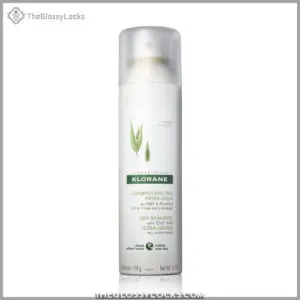 View On Amazon
View On Amazon - The numbers speak volumes: Market volume hit 56,087.9 thousand units by 2021, jumping 7.9% between 2019 and 2022, with projections showing 8.2% annual growth through 2030.
- Urban professionals drive demand: Fast-paced lifestyles and workplace expectations make dry shampoo for Asian hair a practical solution for maintaining healthy Asian hair between washes.
- E-commerce impact fuels accessibility: Online platforms have made best dry shampoo products available across diverse markets, from Seoul to Singapore.
- Cultural adaptation matters: Brands now formulate specifically for Asian hair’s thickness and texture, addressing hair volume and texture needs while following ingredient trends toward natural formulations.
Demand for Natural and Paraben-Free Formulas
What’s driving organic growth at an 8.54% CAGR? Your concerns about health motivations and paraben avoidance are reshaping the industry. Nearly 48% of you now skip products with parabens, while 65% prioritize scalp health when choosing dry shampoo ingredients.
Brand innovation has responded—23% of market revenue now comes from natural formulas, with paraben-free hair care product ingredients driving 25% higher customer loyalty.
Consumer behavior shows 41% of younger users willingly pay more for clean-label, organic dry shampoo options that respect both your hair and scalp wellness. The rising beauty awareness is also a factor driving market demand, according to this industry report.
Urban Professionals and Dry Shampoo Adoption
When you’re juggling back-to-back meetings and a packed commute, washing your hair can feel like one more thing you don’t have time for—which is exactly why urban professionals across Asia are turning to dry shampoo as their secret weapon for looking polished on the go. Your hectic schedules demand hair care that works as efficiently as you do, and the convenience factor here is real—dry shampoo for Asian hair addresses oily hair in minutes, giving you that confidence boost without the time commitment of a full wash and style.
Picture your typical workday scenario:
- You’re rushing from your 7 AM client call straight into afternoon presentations, and your roots are showing shine by lunchtime.
- That post-gym refresh before evening drinks becomes simple when you’ve got dry shampoo stashed in your desk drawer.
- Your workplace fashion stays camera-ready even during those unexpected video conferences, thanks to quick hair styling touch-ups.
Innovations for Asian Hair Needs
Rice-based formulas and fermented ingredients are transforming how dry shampoo works for Asian hair, with brands launching pH-balanced options that actually respect your scalp microbiome instead of throwing it off balance.
You’ll find ultra-fine particles that disappear into dark hair without that chalky residue, plus tinted formats specifically designed for choosing dry shampoo for Asian hair that matches your natural color.
These innovations address understanding Asian hair structure—tackling oil absorption while protecting your strands from the brittleness that older formulations caused, giving you product recommendations for Asian hair that finally work with your texture.
Where to Buy Dry Shampoos at Best Value
Finding the right dry shampoo at the best price doesn’t mean you have to compromise on quality. You’ve got options—whether you prefer the convenience of online shopping, want to save with subscriptions, or need a travel-sized option for your next trip.
Let’s break down where to shop smart and stretch your dollar without sacrificing results.
Online Retailers Vs. Local Stores
You’ve got two main paths for snagging dry shampoo—scrolling through online shops or heading to your local beauty store—and each has its own perks depending on whether you’re hunting for variety or need that bottle in your hands today.
Online retailers win on price comparison and hair care product selection, especially for product recommendations for Asian hair that local stores don’t always stock.
Brick-and-mortar shops let you check product authenticity instantly and get immediate help matching formulas to your hair type, plus return policies are simpler when something doesn’t work for your texture.
Subscription and Bulk Purchase Options
Stocking up on your go-to formula—whether through auto-ship subscriptions or buying in bulk—keeps your bathroom shelf full and often shaves 15 to 30 percent off retail prices compared to one-off purchases.
Here’s what you’ll notice with subscription savings and bulk discounts on hair care products:
- Auto-delivery programs from brands lock in lower prices per bottle
- Loyalty programs reward repeat orders with points toward future hair products
- Refill frequency flexibility lets you adjust shipments when your hair care routine changes
- Bulk packs (three to six bottles) cut costs without committing to monthly deliveries
- Subscription bundles pair dry shampoo with complementary hair cleansing products at reduced rates
Most platforms let you pause or cancel anytime, so there’s no risk if your texture needs shift.
Tips for Finding Deals and Discounts
Savvy shoppers track launch cycles, holiday markdowns, and flash sales like they’re keeping tabs on the weather—because timing a purchase right can drop your cost per can by half or more.
Sign up for brand newsletters to receive discount codes before anyone else, stack manufacturer coupons with retailer offers, and check dry shampoo reviews on deal forums where users share clearance sales on hair care products they’ve spotted.
Travel-Friendly Dry Shampoo Formats
On-the-go formats—from mini aerosols to powder sachets—slip into carry-ons without triggering TSA limits or leaking onto your favorite blouse. Look for TSA compliance labels (under 3.4 oz), spill-proof packaging like twist-cap bottles, and single-use sachets perfect for sustainable travel.
These travel-friendly dry shampoos keep your hair type refreshed during long flights without adding bulk to your bag.
Frequently Asked Questions (FAQs)
Does dry shampoo work on all hair types?
Yes, dry shampoo works across hair types, but performance varies based on hair texture, scalp sensitivity, and product formulation.
Oily hair benefits most from oil-absorbing ingredients, while fine hair needs lightweight formulas that add volume without weighing strands down.
How often should I use dry shampoo?
Most stylists recommend using dry shampoo no more than two to three times weekly between washes. Overusing it can lead to scalp buildup, clogged follicles, and irritation—especially with Asian hair’s natural oiliness.
Balance dry shampoo usage with regular washing to maintain hair health and scalp health.
Is dry shampoo better than traditional shampoo?
Neither is inherently better—they serve different purposes in hair care. Traditional shampoo provides thorough cleansing and maintains scalp health, while dry shampoo offers a convenient washing alternative between washes.
Long-term effects matter: overusing dry shampoo risks hair damage and buildup, compromising hair health through inadequate hair cleansing.
Does dry shampoo damage hair?
Dry shampoo won’t damage your hair when used correctly, but overuse leads to scalp buildup, follicle clogging, and hair breakage. Daily application disrupts your scalp’s microbiome, potentially triggering irritation.
Ingredient safety matters—choose formulas supporting hair health over harsh chemicals.
Does dry shampoo work on curly hair?
Absolutely—dry shampoo works on curly hair when you choose the right product formulation and application techniques.
Curl pattern impact matters: looser waves absorb powder differently than tight coils, so match your hair texture to the formula for best results.
How does humidity affect dry shampoo performance?
High moisture can be a bit of a spoiler for dry shampoo performance. Humidity reactivates absorbed oils, reducing product effectiveness and causing hair to look greasy faster.
Application techniques and formulation stability matter—some hair types fare better than others with proper hair care timing.
Are aerosol or powder formulas better for Asian hair?
It depends on your hair type and scalp sensitivity. Aerosol formulas distribute evenly and work fast, making them ideal for thick hair.
Powder formulas offer precise application and gentler ingredients, perfect for sensitive scalps or fine hair.
Can dry shampoo be used on wet hair?
Here’s the thing about mixing water with dry shampoo: it’s like trying to use an umbrella underwater—you’re missing the point entirely. Dry shampoo works by absorbing oil from your scalp, but on wet hair, the powder can’t grab onto oils effectively. Instead, you’ll end up with clumpy, pasty buildup.
Does dry shampoo protect against UV damage?
Most dry shampoos don’t offer UV protection. They lack ingredient UV filters designed for damage prevention.
If you’re concerned about scalp sun protection and hair health, look for hair care products specifically formulated with UV-blocking ingredients for your hair types.
Conclusion
Your hair’s specific needs aren’t some impossible puzzle—you’ve just spent years using products designed for someone else’s texture. The right dry shampoos for Asian hair aren’t about masking oil with white powder; they’re about understanding how sebum behaves on straight shafts and choosing formulas that actually absorb without leaving evidence.
Test the options that match your lifestyle, whether that’s a quick morning refresh or extending blowouts through humidity. Your scalp will stop overcompensating once you break the daily wash cycle, and you’ll finally stop wondering why nothing seems to work.
- https://www.researchandmarkets.com/report/asia-pacific-dry-shampoo-market
- https://www.grandviewresearch.com/industry-analysis/dry-shampoo-market
- https://www.databridgemarketresearch.com/nucleus/asia-pacific-shampoo-market
- https://viderihair.myshopify.com/blogs/review/best-dry-shampoo-for-asian-hair
- https://viori.com/blogs/updates/the-hidden-wonders-of-japanese-dry-shampoo-what-your-hair-has-been-missing

